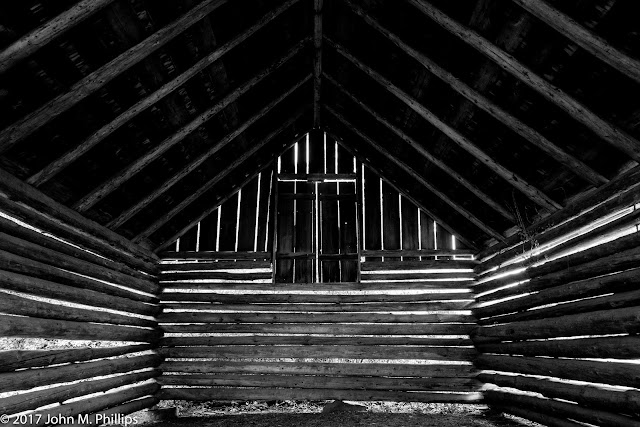Old World Wisconsin is an outdoor museum located about 40 miles southwest of Milwaukee. Situated on over 500 acres of rolling land, it includes a large number of reconstructed residences, farm buildings, meeting halls, and churches built by various mostly European immigrant groups from the 19th century. The structures are furnished with household goods, farm implements, and other equipment from the same era. And it is staffed by volunteers dressed in clothes of the era, who provide information and demonstrations that help bring the era to life.
I spent about three hours walking from settlement to settlement trying to capture some of the history in photographs. Following is some of what I got.
The first image is of the interior of a Catholic church originally built in Milwaukee in 1839 and moved to and reconstructed on site. Unfortunately, unlike with most of the buildings, I was not able to enter this church to obtain detail shots.
I took this shot of one of the church's lovely gothic windows that shows the corresponding window on the opposite side of the church.
A number of the buildings, particularly meeting houses, featured wood burning stoves. As in the photo of the church above, most of these stoves were situated in the center of the room to maximize their efficiency. Here are a couple of the other stoves.
This last is a closeup of the multipurpose stove shown in the previous shot.
The following was a larger home that was unfortunately closed for restoration.
I converted this to a black and white and darkened the blue sky.
As mentioned, there were a large number of outbuildings, including the following.
Here I wanted to incorporate the fence as a foreground element. Unfortunately, the top boards of the fence coincided with the base of the building, which I thought created a bit of compositional confusion.
Below is an interior shot from one of the outbuildings.
Here is another tumbledown outbuilding.
But the surprise was when I entered the low entrance.
The light streaming through the building's cracks confirmed that the building was built for ventilation.
Many of the buildings, particularly outbuildings, were constructed of weathered, unpainted dopvetailed timbers, and I spent some time trying to capture some of the interesting grain that the weathering brought out. Here are a couple of examples.
Interesting also was a home built by Polish immigrants in 1900. The house is distinctive in that, in large part, the wood portion of the exterior walls consists of logs cut in cross-section and set in plaster or stucco. Here is the house as a whole followed by a detail shot.
My favorites, finally, were a couple of "still life" shots of household items bathed in light from nearby windows.
I particularly liked the lace curtain in this last shot.
I strongly recommend a visit to this outdoor historical museum. But be prepared for crowds of school children during the school year. There is also the opportunity for a good deal of walking, though there is a tram that runs through the facility.
John




































